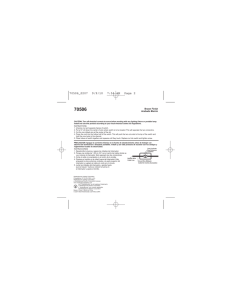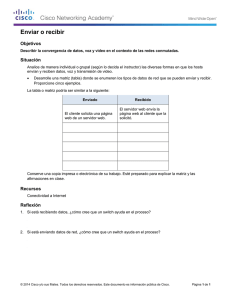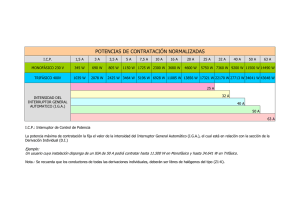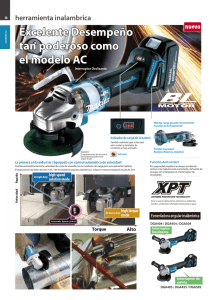Installation 1 3 2 4 5 7 Operation 6 Troubleshooting
Anuncio
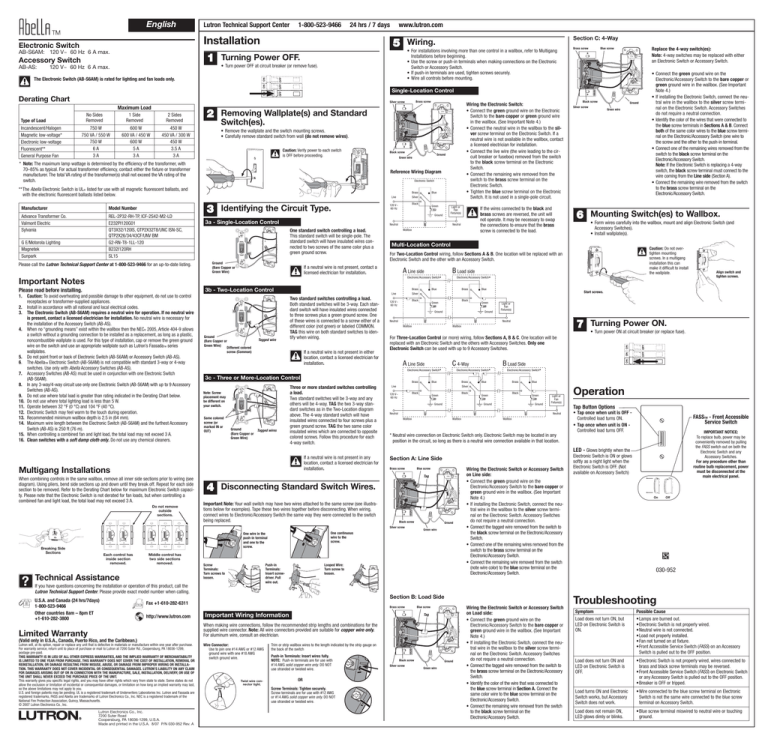
24 hrs / 7 days 5 • For installations involving more than one control in a wallbox, refer to Multigang Installations before beginning. • Use the screw or push-in terminals when making connections on the Electronic Switch or Accessory Switch. • If push-in terminals are used, tighten screws securely. • Wire all controls before mounting. Turning Power OFF. ON ON ON The Electronic Switch (AB-S6AM) is rated for lighting and fan loads only. OFF OFF OFF • Turn power OFF at circuit breaker (or remove fuse). 120 V~ 60 Hz 6 A max. Derating Chart No Sides Removed 1 Side Removed 2 Sides Removed 750 W 750 VA / 550 W 750 W 6A 3A 600 W 600 VA / 450 W 600 W 5A 3A 450 W 450 VA / 300 W 450 W 3.5 A 3A Type of Load 2 Brass screw • Remove the wallplate and the switch mounting screws. • Carefully remove standard switch from wall (do not remove wires). Caution: Verify power to each switch is OFF before proceeding. Advance Transformer Co. Valmont Electric Sylvania REL-2P32-RH-TP, ICF-2S42-M2-LD E232PI120G01 QT3X32/120IS, QTP2X32T8/UNC ISN-SC, QTP2X26/34/43CF/UNV BM G2-RN-T8-1LL-120 B232I120RH SL15 G E/Motorola Lighting Magnetek Sunpark Please call the Lutron Technical Support Center at 1-800-523-9466 for an up-to-date listing. Black screw Ground Green wire Reference Wiring Diagram Electronic Switch **The Abella Electronic Switch is UL® listed for use with all magnetic fluorescent ballasts, and with the electronic fluorescent ballasts listed below. Model Number Wiring the Electronic Switch: • Connect the green ground wire on the Electronic Switch to the bare copper or green ground wire in the wallbox. (See Important Note 4.) • Connect the neutral wire in the wallbox to the silver screw terminal on the Electronic Switch. If a neutral wire is not available in the wallbox, contact a licensed electrician for installation. • Connect the live wire (the wire leading to the circuit breaker or fusebox) removed from the switch to the black screw terminal on the Electronic Switch. • Connect the remaining wire removed from the switch to the brass screw terminal on the Electronic Switch. • Tighten the blue screw terminal on the Electronic Switch. It is not used in a single-pole circuit. Removing Wallplate(s) and Standard Switch(es). * Note: The maximum lamp wattage is determined by the efficiency of the transformer, with 70–85% as typical. For actual transformer efficiency, contact either the fixture or transformer manufacturer. The total VA rating of the transformer(s) shall not exceed the VA rating of the switch. Manufacturer Brass Silver Live 3 Identifying the Circuit Type. Blue Black 120 V~ 60 Hz Green Light or Fan Fixture(s) Ground 3a - Single-Location Control Neutral One standard switch controlling a load. This standard switch will be single-pole. The standard switch will have insulated wires connected to two screws of the same color plus a green ground screw. Ground (Bare Copper or Green Wire) Wallbox • Connect the green ground wire on the Electronic/Accessory Switch to the bare copper or green ground wire in the wallbox. (See Important Note 4.) • If installing the Electronic Switch, connect the neutral wire in the wallbox to the silver screw terminal on the Electronic Switch. Accessory Switches do not require a neutral connection. • Identify the color of the wires that were connected to the blue screw terminals in Sections A & B. Connect both of the same color wires to the blue screw terminal on the Electronic/Accessory Switch (one wire to the screw and the other to the push-in terminal. • Connect one of the remaining wires removed from the switch to the black screw terminal on the Electronic/Accessory Switch. Note: If the Electronic Switch is replacing a 4-way switch, the black screw terminal must connect to the wire coming from the Line side (Section A). • Connect the remaining wire removed from the switch to the brass screw terminal on the Electronic/Accessory Switch. 3b - Two-Location Control A Line side If a neutral wire is not present in either location, contact a licensed electrician for installation. 6 Ground Green wire Mounting Switch(es) to Wallbox. • Form wires carefully into the wallbox, mount and align Electronic Switch (and Accessory Switches). • Install wallplate(s). Caution: Do not overtighten mounting screws. In a multigang installation this can make it difficult to install the wallplate. B Load side Blue Black 120 V~ 60 Hz Electronic/Accessory Switch* Brass Black Green Ground Blue Green Ground Neutral Light or Fan Fixture(s) 7 Neutral Wallbox Wallbox Turning Power ON. • Turn power ON at circuit breaker (or replace fuse). For Three-Location Control (or more) wiring, follow Sections A, B & C. One location will be replaced with an Electronic Switch and the others with Accessory Switches. Only one Electronic Switch can be used with up to 9 Accessory Switches. A Line Side C 4-Way Electronic/Accessory Switch* B Load Side Electronic/Accessory Switch* Electronic/Accessory Switch* 3c - Three or More-Location Control Brass Note: Screw placement may be different on your switch. Same colored screw (or marked IN or OUT) Ground Tagged wires (Bare Copper or Green Wire) Three or more standard switches controlling a load. Two standard switches will be 3-way and any others will be 4-way. TAG the two 3-way standard switches as in the Two-Location diagram above. The 4-way standard switch will have insulated wires connected to four screws plus a green ground screw. TAG the two same color insulated wires which are connected to opposite colored screws. Follow this procedure for each 4-way switch. Blue Brass Silver Live Black 120 V~ 60 Hz Black Green Ground Blue Brass Black Green Ground Blue Green Ground Neutral Light or Fan Fixture(s) Tap Button Options Neutral Wallbox Wallbox Operation Wallbox • Tap once when unit is OFF Controlled load turns ON. • Tap once when unit is ON Controlled load turns OFF. FASSTM - Front Accessible Service Switch IMPORTANT NOTICE: To replace bulb, power may be conveniently removed by pulling the FASS switch out on both the Electronic Switch and any Accessory Switches. For any procedure other than routine bulb replacement, power must be disconnected at the main electrical panel. * Neutral wire connection on Electronic Switch only. Electronic Switch may be located in any position in the circuit, so long as there is a neutral wire connection available in that location. LED - Glows brightly when the If a neutral wire is not present in any location, contact a licensed electrician for installation. Multigang Installations When combining controls in the same wallbox, remove all inner side sections prior to wiring (see diagram). Using pliers, bend side sections up and down until they break off. Repeat for each side section to be removed. Refer to the Derating Chart below for maximum Electronic Switch capacity. Please note that the Electronic Switch is not derated for fan loads, but when controlling a combined fan and light load, the total load may not exceed 3 A. Do not remove outside sections. Section A: Line Side Brass screw 4 Disconnecting Standard Switch Wires. Important Note: Your wall switch may have two wires attached to the same screw (see illustrations below for examples). Tape these two wires together before disconnecting. When wiring, connect wires to Electronic/Accessory Switch the same way they were connected to the switch being replaced. Black screw ? Middle control has two side sections removed. Technical Assistance Screw Terminals: Turn screws to loosen. Ground Green wire One continuous wire to the screw. One wire in the push-in terminal and one to the screw. Each control has inside section removed. Blue screw Tag Silver screw Breaking Side Sections Align switch and tighten screws. Start screws. ON Tagged wire Brass Silver Live Two standard switches controlling a load. Both standard switches will be 3-way. Each standard switch will have insulated wires connected to three screws plus a green ground screw. One of these wires is connected to a screw either of a different color (not green) or labeled COMMON. TAG this wire on both standard switches to identify when wiring. Black screw Silver screw Multi-Location Control If a neutral wire is not present, contact a licensed electrician for installation. Ground (Bare Copper or Green Wire) Different colored screw (Common) Replace the 4-way switch(es): Note: 4-way switches may be replaced with either an Electronic Switch or Accessory Switch. Blue screw For Two-Location Control wiring, follow Sections A & B. One location will be replaced with an Electronic Switch and the other with an Accessory Switch. Important Notes 1. Caution: To avoid overheating and possible damage to other equipment, do not use to control receptacles or transformer-supplied appliances. 2. Install in accordance with all national and local electrical codes. 3. The Electronic Switch (AB-S6AM) requires a neutral wire for operation. If no neutral wire is present, contact a licensed electrician for installation. No neutral wire is necessary for the installation of the Accessory Switch (AB-AS). 4. When no “grounding means” exist within the wallbox then the NEC® 2005, Article 404-9 allows a switch without a grounding connection to be installed as a replacement, as long as a plastic, noncombustible wallplate is used. For this type of installation, cap or remove the green ground wire on the switch and use an appropriate wallplate such as Lutron’s FassadaTM series wallplates. 5. Do not paint front or back of Electronic Switch (AB-S6AM) or Accessory Switch (AB-AS). 6. The AbellaTM Electronic Switch (AB-S6AM) is not compatible with standard 3-way or 4-way switches. Use only with Abella Accessory Switches (AB-AS). 7. Accessory Switches (AB-AS) must be used in conjunction with one Electronic Switch (AB-S6AM). 8. In any 3-way/4-way circuit use only one Electronic Switch (AB-S6AM) with up to 9 Accessory Switches (AB-AS). 9. Do not use where total load is greater than rating indicated in the Derating Chart below. 10. Do not use where total lighting load is less than 5 W. 11. Operate between 32 °F (0 °C) and 104 °F (40 °C). 12. Electronic Switch may feel warm to the touch during operation. 13. Recommended minimum wallbox depth is 2.5 in (64 mm). 14. Maximum wire length between the Electronic Switch (AB-S6AM) and the furthest Accessory Switch (AB-AS) is 250 ft (76 m). 15. When controlling a combined fan and light load, the total load may not exceed 3 A. 16. Clean switches with a soft damp cloth only. Do not use any chemical cleaners. If the wires connected to the black and brass screws are reversed, the unit will not operate. It may be necessary to swap the connections to ensure that the brass screw is connected to the load. Neutral Electronic/Accessory Switch* Please read before installing. Brass screw Single-Location Control Silver screw Maximum Load Section C: 4-Way Wiring. OFF OFF OFF 1 Accessory Switch www.lutron.com ON AB-S6AM: 120 V~ 60 Hz 6 A max. Incandescent/Halogen Magnetic low-voltage* Electronic low-voltage Fluorescent** General Purpose Fan 1-800-523-9466 Installation Electronic Switch AB-AS: Lutron Technical Support Center ON English Push-in Terminals: Insert screwdriver. Pull wire out. Looped Wire: Turn screw to loosen. Wiring the Electronic Switch or Accessory Switch on Line side: • Connect the green ground wire on the Electronic/Accessory Switch to the bare copper or green ground wire in the wallbox. (See Important Note 4.) • If installing the Electronic Switch, connect the neutral wire in the wallbox to the silver screw terminal on the Electronic Switch. Accessory Switches do not require a neutral connection. • Connect the tagged wire removed from the switch to the black screw terminal on the Electronic/Accessory Switch. • Connect one of the remaining wires removed from the switch to the brass screw terminal on the Electronic/Accessory Switch. • Connect the remaining wire removed from the switch (note wire color) to the blue screw terminal on the Electronic/Accessory Switch. Electronic Switch is ON or glows softly as a night light when the Electronic Switch is OFF. (Not available on Accessory Switch) On Off 030-952 If you have questions concerning the installation or operation of this product, call the Lutron Technical Support Center. Please provide exact model number when calling. U.S.A. and Canada (24 hrs/7days) 1-800-523-9466 Other countries 8am – 8pm ET +1-610-282-3800 Section B: Load Side Fax +1-610-282-6311 Brass screw http://www.lutron.com Important Wiring Information Blue screw Tag When making wire connections, follow the recommended strip lengths and combinations for the supplied wire connector. Note: All wire connectors provided are suitable for copper wire only. For aluminum wire, consult an electrician. Limited Warranty (Valid only in U.S.A., Canada, Puerto Rico, and the Caribbean.) Lutron will, at its option, repair or replace any unit that is defective in materials or manufacture within one year after purchase. For warranty service, return unit to place of purchase or mail to Lutron at 7200 Suter Rd., Coopersburg, PA 18036-1299, postage pre-paid. THIS WARRANTY IS IN LIEU OF ALL OTHER EXPRESS WARRANTIES, AND THE IMPLIED WARRANTY OF MERCHANTABILITY IS LIMITED TO ONE YEAR FROM PURCHASE. THIS WARRANTY DOES NOT COVER THE COST OF INSTALLATION, REMOVAL OR REINSTALLATION, OR DAMAGE RESULTING FROM MISUSE, ABUSE, OR DAMAGE FROM IMPROPER WIRING OR INSTALLATION. THIS WARRANTY DOES NOT COVER INCIDENTAL OR CONSEQUENTIAL DAMAGES. LUTRON’S LIABILITY ON ANY CLAIM FOR DAMAGES ARISING OUT OF OR IN CONNECTION WITH THE MANUFACTURE, SALE, INSTALLATION, DELIVERY, OR USE OF THE UNIT SHALL NEVER EXCEED THE PURCHASE PRICE OF THE UNIT. This warranty gives you specific legal rights, and you may have other rights which vary from state to state. Some states do not allow the exclusion or limitation of incidental or consequential damages, or limitation on how long an implied warranty may last, so the above limitations may not apply to you. U.S. and foreign patents may be pending. UL is a registered trademark of Underwriters Laboratories Inc. Lutron and Fassada are registered trademarks, FASS and Abella are trademarks of Lutron Electronics Co., Inc. NEC is a registered trademark of the National Fire Protection Association, Quincy, Massachusetts. © 2007 Lutron Electronics Co., Inc. Lutron Electronics Co., Inc. 7200 Suter Road Coopersburg, PA 18036-1299, U.S.A. Made and printed in the U.S.A. 8/07 P/N 030-952 Rev. A Wire Connector: Use to join one #14 AWG or #12 AWG ground wire with one #18 AWG switch ground wire. Twist wire connector tight. Trim or strip wallbox wires to the length indicated by the strip gauge on the back of the switch Push-in Terminals: Insert wires fully. NOTE: Push-in terminals are for use with #14 AWG solid copper wire only. DO NOT use stranded or twisted wire. OR Screw Terminals: Tighten securely. Screw terminals are for use with #12 AWG or #14 AWG solid copper wire only. DO NOT use stranded or twisted wire. Black screw Silver screw Ground Green wire Wiring the Electronic Switch or Accessory Switch on Load side: • Connect the green ground wire on the Electronic/Accessory Switch to the bare copper or green ground wire in the wallbox. (See Important Note 4.) • If installing the Electronic Switch, connect the neutral wire in the wallbox to the silver screw terminal on the Electronic Switch. Accessory Switches do not require a neutral connection. • Connect the tagged wire removed from the switch to the brass screw terminal on the Electronic/Accessory Switch. • Identify the color of the wire that was connected to the blue screw terminal in Section A. Connect the same color wire to the blue screw terminal on the Electronic/Accessory Switch. • Connect the remaining wire removed from the switch to the black screw terminal on the Electronic/Accessory Switch. Troubleshooting Symptom Load does not turn ON, but LED on Electronic Switch is ON. Possible Cause •Lamps are burned out. •Electronic Switch is not properly wired. •Neutral wire is not connected. •Load not properly installed. •Fan not turned on at fixture. •Front Accessible Service Switch (FASS) on an Accessory Switch is pulled out to the OFF position. Load does not turn ON and LED on Electronic Switch is OFF. •Electronic Switch is not properly wired, wires connected to brass and black screw terminals may be reversed. •Front Accessible Service Switch (FASS) on Electronic Switch or any Accessory Switch is pulled out to the OFF position. •Breaker is OFF or tripped. Load turns ON and Electronic Switch works, but Accessory Switch does not work. •Wire connected to the blue screw terminal on Electronic Switch is not the same wire connected to the blue screw terminal on Accessory Switch. Load does not remain ON, LED glows dimly or blinks. •Blue screw terminal miswired to neutral wire or touching ground. Centro de Soporte Técnico de Lutron 1-800-523-9466 24 horas / 7 días Instalación 1 Interruptor Accesorio Apagado. OFF OFF OFF ON ON ON El Interruptor Electrónico (AB-S6AM) está diseñado solamente para cargas de iluminación y de ventiladores. Tabla de Reducción de las Capacidades Normales 1 Lateral Extraído 2 Laterales Extraídos 750 W 750 VA / 550 W 750 W 6A 600 W 600 VA / 450 W 600 W 5A 450 W 450 VA / 300 W 450 W 3,5 A 3A 3A 3A 2 Remoción de la(s) placa(s) de pared e interruptor(es) estándar. • Retire la placa de pared y los tornillos de montaje del interruptor. • Retire el interruptor estándar de la pared con cuidado (no saque los cables). Cuidado: Compruebe que la alimentación a los interruptores esté desconectada antes de proseguir. * Nota: El wataje total de las lámparas está determinado por la eficiencia del transformador, siendo 70–85% lo típico. Para la eficiencia real, contacte al fabricante del artefacto o del transformador. Los VA totales del transformador(es) no deben exceder los del interruptor. **El Interruptor Electrónico Abella está Listado en UL® para usar con todos los balastos magnéticos y electrónicos fluorescentes que se listan más abajo. Fabricante Número de Modelo Advance Transformer Co. Valmont Electric Sylvania REL-2P32-RH-TP, ICF-2S42-M2-LD E232PI120G01 QT3X32/120IS, QTP2X32T8/UNC ISN-SC, QTP2X26/34/43CF/UNV BM G2-RN-T8-1LL-120 B232I120RH SL15 G E/Motorola Lighting Magnetek Sunpark Por favor llame al Centro de Soporte Técnico de Lutron al 1-800-523-9466 para una lista actualizada. Notas importantes Por favor lea antes de instalar. 1. Cuidado: Para evitar el recalentamiento y posibles daños a otros equipos, no utilizar para controlar receptáculos o aparatos con alimentación a través de un transformador. 2. La instalación se debe realizar de acuerdo con todos los códigos eléctricos nacionales y locales. 3. El Interruptor Electrónico (AB-S6AM) requiere un cable neutro para su funcionamiento. Si no hay cable neutro presente, contacte a un electricista calificado para la instalación. No es necesario un cable neutro para la instalación del Interruptor Accesorio (AB-AS). 4. Cuando dentro de la caja de empotrar no hay “medios de conexión a tierra” el Artículo 404-9 de NEC® 2005 permite la instalación de un interruptor sin conexión a tierra como reemplazo, siempre y cuando se utilice una placa de pared plástica e incombustible. Para efectuar este tipo de instalación tape o retire el cable verde de conexión a tierra del interruptor y use una placa de pared adecuada como las de la serie FassadaTM de Lutron. 5. No pinte el frente o la parte posterior del Interruptor Electrónico (AB-S6AM) o Accesorio (AB-AS). 6. El Interruptor Electrónico AbellaTM (AB-S6AM) no es compatible con los interruptores de 3-posiciones o 4-posiciones. Utilice solamente con los Interruptores Accesorios Abella (AB-AS). 7. Los Interruptores Accesorios (AB-AS) deben usarse en conjunto con un Interruptor Electrónico (AB-S6AM). 8. En cualquier circuito de 3- /4-puntos use sólo un Interruptor Electrónico (AB-S6AM) con hasta 9 Interruptores Accesorios (AB-AS). 9. No lo use donde la carga total sea mayor que la nominal indicada en el Cuadro de Reducción de la Potencia Nominal de más abajo. 10. No lo use donde la carga de iluminación total sea menor que 5 W. 11. Mantenga la temperatura de funcionamiento entre 0 °C (32 °F) y 40 °C (104 °F). 12. El Interruptor Electrónico puede calentarse durante el funcionamiento. 13. La profundidad mínima recomendada de la caja de empotrar es de 64 mm (2,5 in). 14. El máximo largo de cable entre el Interruptor Electrónico (AB-S6AM) y el Interruptor Accesorio más lejano (AB-AS) es de 76 m (250 ft). 15. Cuando se controla un ventilador y una carga de luz combinados, la carga total no debe exceder los 3 A. 16. Limpie los interruptores con un paño suave húmedo solamente. No utilice productos químicos de limpieza. 3 Identificación del tipo de circuito. secciones exteriores. Quiebre de las Secciones Laterales ? A cada control se le ha quitado la sección interior. 3a – Control de ubicación única Si usted tiene alguna duda con respecto a la instalación o al funcionamiento de este producto, comuníquese con el Centro de Soporte Técnico de Lutron. Por favor, indique el modelo exacto al llamar. E.U.A. y Canadá (24 horas/7 días a la semana) Fax: +1-610-282-6311 1-800-523-9466 Otros países 8 a.m. – 8 p.m. (Hora del Este) http://www.lutron.com +1-610-282-3800 Garantía Limitada (Válido solamente en los E.U.A., Canadá, Puerto Rico y el Caribe.) Lutron, a discreción propia, reparará o reemplazará las unidades con fallas en sus materiales o fabricación dentro del año posterior a la compra de las mismas. Para obtener el servicio de garantía, remita la unidad al lugar donde la adquirió o envíela a Lutron, 7200 Suter Rd., Coopersburg, PA 18036-1299, con servicio postal prepago. ESTA GARANTÍA REEMPLAZA A TODA OTRA GARANTÍA EXPRESA Y LA GARANTÍA IMPLÍCITA DE COMERCIABILIDAD ESTÁ LIMITADA A UN AÑO DESDE LA FECHA DE COMPRA. ESTA GARANTÍA NO CUBRE EL COSTO DE INSTALACIÓN, DE REMOCIÓN, NI DE REINSTALACIÓN, NI LOS DAÑOS PROVOCADOS POR USO INCORRECTO O ABUSO NI LOS DAÑOS RESULTANTES DE UN CABLEADO O UNA INSTALACIÓN INCORRECTOS. ESTA GARANTÍA NO CUBRE DAÑOS INCIDENTALES O INDIRECTOS. LA RESPONSABILIDAD DE LUTRON ANTE UNA DEMANDA POR DAÑOS CAUSADOS POR O RELACIONADOS CON LA FABRICACIÓN, VENTA, INSTALACIÓN, ENTREGA O USO DE LA UNIDAD NO EXCEDERÁ EN NINGÚN CASO EL PRECIO DE COMPRA DE LA UNIDAD. La presente garantía le otorga derechos legales específicos y usted puede tener otros derechos que varían según el estado. Algunos estados no admiten la exclusión o limitación de los daños incidentales o indirectos, ni las limitaciones en la duración de las garantías implícitas, de modo que las limitaciones anteriores pueden no ser aplicables en su caso. Patentes de E.U.A. y extranjeras pueden estar pendientes. UL es una marca registrada de Underwriters Laboratories Inc. Lutron es una marca comerciales registradas y FASS, Fassada, y Abella son marcas registradas de Lutron Electronics Co., Inc. NEC es una marca registrada de National Fire Protection Association, Quincy, Massachusetts. © 2007 Lutron Electronics Co., Inc. Lutron Electronics Co., Inc. 7200 Suter Road Coopersburg, PA 18036-1299 E.U.A. Hecho e impreso en los E.U.A. 8/07 P/N 030-952 Rev. A Verde Tierra (Cable de cobre sin aislamiento o cable verde) 3b – Control de dos ubicaciones Neutro Si un cable neutro no está presente en uno de los lugares, contacte a un electricista autorizado para la instalación. Tornillo negro Tornillo plateado 6 Nota: Los interruptores de 4-puntos pueden ser reemplazados o bien con un Interruptor Electrónico o con uno Accesorio. • Conecte el cable de descarga a tierra verde del Interruptor Electrónico/Accesorio al cable de descarga a tierra de cobre sin aislamiento, o al cable a tierra verde de la caja de empotrar. (Vea la Nota Importante N 4.) • Si está instalando el Interruptor Electrónico, conecte el cable neutro de la caja de empotrar al borne de tornillo plateado en el Interruptor Electrónico. Los Interruptores Accesorios no requieren conexión al neutro. • Identifique el color de los cables que se conectan a los bornes de tornillo azules en las Secciones A y B. Conecte ambos cables del mismo color al borne de tornillo azul en el Interruptor Electrónico/Accesorio (un cable al borne de tornillo y el otro al de presión. • Conecte uno de los cables restantes extraídos del interruptor al borne de tornillo negro en el Interruptor Electrónico/Accesorio. Nota: Si el Interruptor Electrónico está reemplazando a un interruptor de 4-vías, el borne de tornillo negro debe conectarse al cable procedente del Lado de la línea (Sección A). • Conecte el cable restante extraído del interruptor al borne de tornillo de cobre del Interruptor Electrónico/Accesorio. Para el cableado de Control de Dos Ubicaciones, siga las Secciones A y B. Una ubicación será reemplazada con un Interruptor Electrónico y la otra con un Interruptor Accesorio. Lado de la carga A Negro 120 V~ 60 Hz Montaje del(os) Interruptor(es) en la caja de empotrar. Cuidado: No ajuste demasiado los tornillos de montaje. En una instalación de dispositivos múltiples esto puede dificultar la instalación de la placa de pared. Lado de la carga B Interruptor Electrónico/Accesorio* Cobre Plata Tierra Cable verde • Coloque los cables cuidadosamente en la caja de empotrar, monte y alinee el Interruptor Electrónico (y los Interruptores Accesorios). • Coloque las placas de pared. Control multi-locación Vivo Reemplace dos interruptores estándar que controlan una carga Ambos interruptores estándar serán de 3 vías. Cada interruptor estándar tendrá cables aislados conectados con tres tornillos más un tornillo a tierra de color verde. Uno de estos cables está conectado con un tornillo de distinto color (no verde) o etiquetado como COMÚN. IDENTIFIQUE este cable en ambos interruptores estándar para poder distinguirlo durante el cableado. Si los cables conectados a los tornillos negro y de cobre son invertidos, la unidad no funcionará. Puede ser necesario cambiar las conexiones para asegurar que el tornillo de cobre está conectado a la carga. Caja de Pared Si un cable neutro no está presente, contacte a un electricista autorizado para la instalación. Tierra Cable rotu(Cable de cobre lado sin aislamiento Tornillo de distinto o cable verde) color (Común) Artefacto(s) de Luz o de Ventilador Neutro Un interruptor estándar controlando una carga. Este interruptor estándar será unipolar y tendrá cables aislados conectados con dos tornillos del mismo color más un tornillo a tierra de color verde. Interruptor Electrónico/Accesorio* Azul Cobre Negro Verde Tierra Azul Verde Tierra Neutro Artefacto(s) de Luz o de Ventilador Alinee el interruptor y ajuste los tornillos. Tornillos de inicio. Neutro Caja de Pared 7 Caja de Pared Para el cableado de Control desde tres ubicaciones (o más), siga las Secciones A, B y C. Una ubicación será reemplazada con un Interruptor Electrónico y las otras con Interruptores Accesorios. Sólo un Interruptor Electrónico puede usarse con hasta 9 Interruptores Accesorios. Lado de la carga A C 4 Puntos Interruptor Electrónico/Accesorio* Encendido. • Encienda desde el cortacircuito (o vuelva a colocar el fusible). Lado de la carga B Interruptor Electrónico/Accesorio* Interruptor Electrónico/Accesorio* 3c – Control de tres o más ubicaciones Cobre Nota: La ubicación de los tornillos puede ser diferente en su interruptor. Tornillo del mismo color (o señalado como IN o OUT) Tierra Cables rotu(Cable de cobre lados sin aislamiento o cable verde) Tres o más interruptores estándar controlando una carga. Dos interruptores estándar serán de 3-puntos y los demás de 4-. ROTULE los dos interruptores estándar de 3-puntos tal como se muestra en el diagrama de Dos Ubicaciones anterior. El interruptor estándar de 4-puntos tendrá cables aislados conectados con cuatro tornillos, además de un tornillo de tierra de color verde. ROTULE los dos cables aislados del mismo color que están conectados con los tornillos de colores opuestos. Siga este procedimiento para cada interruptor de 4-puntos. Si un cable neutro no está presente, contacte a un electricista autorizado para la instalación. 4 Azul Cobre Plata Vivo Negro 120 V~ 60 Hz Negro Verde Tierra Bornes de tornillo: Afloje los tornillos. Caja de Pared Caja de Pared Tierra Artefacto(s) de Luz o de Ventilador Caja de Pared Sección A: Lado de la línea Tornillo de cobre Tornillo azul Identificación Tornillo negro Tornillo plateado Tierra Cable verde Cableado del Interruptor Electrónico o Accesorio del lado de la Línea: • Conecte el cable de descarga a tierra verde del Interruptor Electrónico/Accesorio al cable de descarga a tierra de cobre sin aislamiento, o al cable a tierra verde de la caja de empotrar. (Vea la Nota Importante 4.) • Si está instalando el Interruptor Electrónico, conecte el cable neutro de la caja de empotrar al borne de tornillo plateado en el Interruptor Electrónico. Los Interruptores Accesorios no requieren conexión al neutro. • Conecte el cable rotulado que se retiró del interruptor al terminal de tornillo negro en el Interruptor Electrónico/Accesorio. • Conecte uno de los cables restantes extraídos del interruptor al borne de tornillo de cobre del Interruptor Electrónico /Accesorio. • Conecte el cable restante extraído del interruptor (observe el color del cable) al borne de tornillo azul del Interruptor Electrónico /Accesorio. Sección B: Lado de la carga Tornillo azul Identificación Información Importante sobre Cableado Cuando se hagan las conexiones de los cables, la sección sin aislamiento debe respetar las combinaciones y longitudes recomendadas para el conector de cable provisto. Nota: Todos los conectores de cable ya provistos son para cable de cobre solamente. Para cable de aluminio, consulte a un electricista. Conector de cable trenzado ajustado. Verde * La conexión del cable neutro es en el Interruptor Electrónico solamente. El Interruptor Electrónico puede ubicarse en cualquier posición en el circuito, mientras hay disponible una conexión al neutro en esa ubicación. Tornillo de cobre Cable conector: Use para unir un cable de tierra #14 AWG o #12 AWG con un cable de tierra #18 AWG del interruptor. Negro Azul Neutro Cable atado: Afloje el tornillo. Bornes a presión: Introduzca el destornillador y extraiga el cable. Verde Cobre Neutro Un cable continuo al tornillo. Un cable en el borne de empujar y uno en el tornillo. Azul Tierra Desconexión de los Cables del Interruptor estándar. Nota Importante: Su interruptor de pared puede tener dos cables conectados al mismo borne de tornillo (vea los ejemplos ilustrados a continuación). Una ambos cables con cinta adhesiva antes de desconectarlos. Cuando realice el cableado al Interruptor Electrónico/Accesorio, conecte los cables de la misma forma que estaban conectados al interruptor que se reemplaza. Al control del medio se le han quitado las secciones laterales Asistencia Técnica Negro 120 V~ 60 Hz Tierra Instalaciones con Varios Componentes Cuando se combinan controles en la misma caja de empotrar, retire todas las secciones interiores antes de cablear (vea el diagrama). Usando pinzas, tuerza las secciones hacia arriba y hacia abajo hasta que se quiebren. Repita esto para cada sección a retirar. Consulte el Cuadro de Reducción de la Potencia Nominal aquí debajo para la máxima capacidad del Interruptor Electrónico. Por favor note que el Interruptor Electrónico no debe reducir su potencia nominal para cargas de ventiladores, pero cuando controla una carga combinada de ventilador y luz, la carga total no debe exceder los 3 A. No retire las Reemplace los interruptor(es) de 4-puntos Tornillo azul ON Incandescente/Halógeno Magnético de Bajo Voltaje* Electrónicas de bajo voltaje Fluorescente** Ventilador para usos generales Cableado del Interruptor electrónico: • Conecte el cable a tierra verde del Interruptor Electrónico al cable de cobre o cable a tierra verde de la caja de empotrar (vea la Nota Importante 4.) • Conecte el cable neutro de la caja de empotrar al borne de tornillo plateado en el Interruptor Electrónico. Si no hay disponible un cable neutro en la caja de empotrar, contacte a un electricista calificado para la instalación. Tornillo negro • Conecte el cable vivo (el cable que lleva al Tierra Cable verde cortacircuitos o a la caja de fusibles) que se extrajo del interruptor al borne de tornillos negro en el Interruptor Electrónico. Diagrama de Referencia de Cableado • Conecte el cable restante extraído del interruptor Interruptor electrónico al borne de tornillo de cobre del Interruptor Electrónico. • Ajuste el borne de tornillo azul del Interruptor Cobre Azul Vivo Plata Electrónico. No se usa en un circuito unipolar. Tornillo plateado Tornillo de cobre Sin Laterales Extraídos Tornillo de cobre Control de Un Solo Lugar Carga Máxima Tipo de Carga • Consulte la sección Instalaciones con Varios Componentes cuando tenga más de un control en una caja de empotrar. • Use los bornes de tornillo o los bornes a presión al realizar conexiones en el Interruptor Electrónico o Accesorio. • Si se usan bornes a presión, ajuste los tornillos fuertemente. • Realice el cableado de todos los controles antes del montaje. • Desconecte la alimentación en el cortacircuito (o quite el fusible). AB-AS: 120 V~ 60 Hz 6 A máx. Sección C: 4 Puntos Cableado. OFF OFF OFF AB-S6AM: 120 V~ 60 Hz 6 A máx. 5 ON Interruptor electrónico www.lutron.com ON Español Recorte o pele los cables de la caja de empotrar hasta la medida indicada en el reverso del interruptor Borneras a presión: Inserte los cables completamente. NOTA: Las borneras a presión sólo se utilizan con cables de cobre sólido #14 AWG. NO utilice cable retorcido ni trenzado. O Bornes de Tornillo: Ajuste con firmeza. Los bornes de tornillo se deben usar sólo con cables de cobre sólido #12 AWG o #14 AWG. NO use cable retorcido ni trenzado. Tornillo negro Tornillo plateado Tierra Cable verde Cableado del Interruptor Electrónico o Accesorio del lado de la Carga: • Conecte el cable de descarga a tierra verde del Interruptor Electrónico/Accesorio al cable de descarga a tierra de cobre sin aislamiento, o al cable a tierra verde de la caja de empotrar. (Vea la Nota Importante 4.) • Si está instalando el Interruptor Electrónico, conecte el cable neutro de la caja de empotrar al borne de tornillo plateado en el Interruptor Electrónico. Los Interruptores Accesorios no requieren conexión al neutro. • Conecte el cable rotulado extraído del interruptor al borne de tornillo de cobre Interruptor Electrónico/Accesorio. • Identifique el color del cable que se conectó al borne de tornillo azul en la Sección A. Conecte el cable del mismo color al tornillo azul en el Interruptor Electrónico/Accesorio. • Conecte el cable restante extraído del interruptor al borne de tornillo negro del Interruptor Electrónico/Accesorio. Operación Opciones de Botones a Presión FASSTM – Interruptor de Servicio Accesible por el Frente • Dé un golpecito cuando la unidad esté APAGADA - La carga controlada se ENCIENDE. • Dé un golpecito cuando la unidad esté ENCENDIDA La carga controlada se APAGA. El LED - Brilla intensamente cuando el Interruptor Electrónico está ENCENDIDO o brilla suavemente como luz nocturna cuando el Interruptor Electrónico está APAGADO. (No disponible para el Interruptor Accesorio) AVISO IMPORTANTE: Para reemplazar la bombilla, debe quitarse la alimentación jalando del interruptor FASS hacia fuera tanto del Interruptor Electrónico como de los Interruptores Accesorios. Para cualquier otro procedimiento que no sea el reemplazo de rutina del foco, la alimentación se debe desconectar en el panel eléctrico principal. Encendido Apagar Solución de problemas Síntoma La carga no se ENCIENDE, pero el LED en el Interruptor Electrónico está Encendido. Posible Causa •Lámparas quemadas •El interruptor Electrónico no está cableado correctamente. •Cable neutron no conectado. •Carga instalada incorrectamente. •Ventilador no encendido en el artefacto. •La posición de APAGADO del Interruptor de Servicio Accesible desde el Frente (FASS) de un Interruptor Accesorio está hacia afuera. La carga no se ENCIENDE, y el LED en el Interruptor Electrónico está APAGADO. •Interruptor Electrónico incorrectamente cableado, los cables a los tornillos de cobre y negro pueden estar invertidos. •La posición de apagado del Interruptor de Servicio Accesible desde el Frente (FASS) del Interruptor Electrónico o de cualquier Interruptor Accesorio está hacia afuera. •El cortacircuito está apagado o se disparó. La carga se ENCIENDE y el Interruptor Electrónico funciona, pero el Interruptor Accesorio no funciona. •El cable conectado al borne de tornillo azul en el Interruptor Electrónico no es el mismo cable conectado al borne de tornillo azul en el Interruptor Accesorio. La carga no permanece ENCENDIDA, el, LED brilla suavemente o parpadea. •El borne del tornillo azul no está conectado correctamente con el neutro o está tocando tierra.

